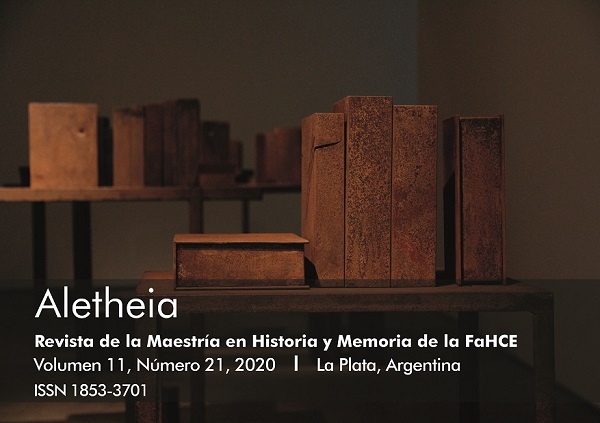Past and present in the resistance of the originary peoples of North America
Main Article Content
Abstract
This article analyzes the link between the collective actions of the original nations of North America and the critical review of the American past. It describes the stigmatizing approach projected by nineteenth-century historiography until well into the twentieth century. It considers the civil rights movement of the 1960s as the matrix stage of Indian historical consciousness. It highlights the role of the native militant organizations that, based on an alternative and critical vision of the past, carried out a set of initiatives aimed at the emancipation and self-government of ancestral peoples. These actions were decisive for the construction of a memory of the resistance of the native peoples of North America.
Downloads
Article Details
This work is licensed under a Creative Commons Attribution 4.0 International (https://creativecommons.org/licenses/by-nc-sa/4.0/deed.es).
References
Adams, S. (2008). The Early American Republic: A Documentary Reader. Maiden (MA): Wiley–Blackwell.
AIM. (1972). Trail of Broken Treaties. 20-Points Positions Paper. Minneapolis, Minnesota, October. Recuperado de: http://www.aimovement.org/ggc/trailofbrokentreaties.html
Bennett, B. (1982). Death, Too, for the Heavy Runner. Missoula, MO: Mountain Press Publishing.
Brown, D. A. (1970). Bury my Heart at Wounded Knee. New York: Henry Holt and Company.
Carr, E. H. (1984). ¿Qué es la historia?. Buenos Aires: Ariel.
Calhoun, P. (2013), Sand Creek Massacre and John Chivington’s explosive actions 11 years after Glorieta Pass. Westword, March 27. Recuperado de: https://www.westword.com/news/carlin-dunne-killed-at-pikes-peak-international-hill-climb-11398427
Churchill, W. & Vander Wall, J. (1990). The Cointelpro’s Papers: Documents from the FBI’s Secret Wars Against Dissent in the United States. Boston: South End Press.
Cox Richardson, H. (2015). The Medal of Honor and the Wounded Knee Massacre. We’re History, New York, March 25. Recuperado de: http://werehistory.org/medal-of-honor-wounded-knee/
Cozzens, P. (2016). The Earth Is Weeping: The Epic Story of the Indian Wars for the American West. New York: Alfred Knopf.
Deloria, V. (1972). Of Utmost Good Faith. New York: Bantam.
Deloria, V. (1988). Custer Died for your Sins. Norman: University of Oklahoma Press.
Dunbar-Ortiz, R. (2014). An Indigenous Peoples' History of the United States. Boston: Beacon Press.
Fitch Kelley, W. (1971). Pine Ridge, 1890; an eye witness account of the events surrounding the figting at Wounded Knee. San Francisco, CA: P, Bovis.
Green, J.R. (1902). Short History of the English People. London: Macmillan.
History.com Editors (2019). Soldiers massacre the wrong camp of Indians, History, July 28. https://www.history.com/this-day-in-history/soldiers-massacre-the-wrong-camp-of-indians
Hoig, S. (1980). The Peace Chiefs of the Cheyennes. Norman, OK: University of Oklahoma Press.
Hutton, P. A. (1985). Forming Military Indian Policy: 'The Only Good Indian Is a Dead Indian'. En P. A. Hutton, P. A., Phil Sheridan and His Army. Lincoln, NE: University of Nebraska Press.
King, P. J. (2016). The Truth about the Wounded Knee Massacre. Indian Country Today, December 30. Recuperado de: https://newsmaven.io/indiancountrytoday/archive/the-truth-about-the-wounded-knee-massacre-PIQqUKeCEEmnLeQn0Q5SOQ/
Landry, A. (2016). Theodore Roosvelt, The Only Good Indians Are the Dead Indians. Indian Country Today, June 28. Recuperado de: https://newsmaven.io/indiancountrytoday/archive/theodore-roosevelt-the-only-good-indians-are-the-dead-indians-oN1cdfuEW02KzOVVyrp7ig/
Lewy, G. (2004). Were American Indians the Victims of Genocide?. Commentary, September. Recuperado de: https://www.commentarymagazine.com/articles/were-american-indians-the-victims-of-genocide/
Lewy, G. (2012). Essays on Genocide and Humanitarian Intervention. Salt Lake City: The University of Utah Press.
Lone Hill, D. (2013). The Wounded Knee medals of honor should be rescinded. The Guardian (International edition), February 18. Recuperado de: https://www.theguardian.com/commentisfree/2013/feb/18/massacre-wounded-knee-medals-honor-rescinded
Mattiessen, P. (1992). In the Spirit of Crazy Horse: the Story of Leonard Peltier and the FBI’s War on the American Indian Movement. New York: Penguin Books.
Morgan, L. (1971). La sociedad primitiva. Barcelona: Ayuso.
Neihardt, J. (2008). Black Elk Speaks: Being the Life Story of a Holy Man of the Oglala Sioux. New York: SUNY Press.
Nemattanew (Chief Roy Crazy Horse). (2002). The North American Genocide. Rancocas, NJ: Powathan Press.
Nichols, D. (1972). Civilization Over Savage: Frederick Jackson Turner and the Indian. South Dakota History. Wisconsin: South Dakota State Historical Society.
Ostler, J. (2004). The Plains Sioux and U.S. Colonialism from Lewis and Clark to Wounded Knee. New York: Cambridge University Press.
Pritzker, B. (2000). A Native American Encyclopedia: History, Culture, and Peoples. New York: Oxford University Press.
Ratledge, M. (2010). BCC marks 26th commemoration of Baker Massacre. Glacier Report, Montana, March 10. Recuperado de: http://www.cutbankpioneerpress.com/glacier_reporter/news/article_bccbcfb1-748e-5209-8856-89d332ef5f50.html
Roosevelt, T. (1896). The Winning of the West. New York and London: G.P. Putnam's Sons.
Sand Creek Massacre (2017). National Historic Site. Colorado. August 17. Recuperado de: https://www.nps.gov/sand/learn/historyculture/index.htm
Schontzler, G. (2012). Blackfeet remember Montana’s greatest Indian massacre. Bozeman Daily Chronicle, Montana, January 25. Recuperado de: https://www.bozemandailychronicle.com/news/sunday/blackfeet-remember-montana-s-greatest-indian-massacre/article_daca1094-4484-11e1-918e-001871e3ce6c.html
Sharpe, J. (1996). “Historia desde abajo”. En P. Burke (ed.), Formas de hacer historia (pp. 38-58). Madrid: Alianza.
Stannard, D. (1993). American Holocaust: The Conquest of the New World: The Conquest of the New World. New York: Oxford University Press.
Sumner, W. G. (1911). Essays of William Graham Sumner, edited by Keller, A. and Davie, M., 2 vols. New Haven, Conn: Yale University Press.
Turner, F.J. (1891). “The Character and Influence of the Indian Trade in Wisconsin”. En H. B. Adams (ed.), John Hopkins Universities Series in Historical and Political Science, 9th ser. Vols. (11-12), November and December.
Turner, F. J. (1896). “Review of Winning of the West”. American Historical Review, 2, October.
Utley, R. M. & Washburn, W. (2002). Indian Wars. New York: American Heritage Press.
Utley, R. M. (2004). The Last Days of the Sioux Nation. New Haven: Yale University Press.
Warrior, R. & Chaat Smith, P. (1996). Like a Hurricane: The Indian Movement from Alcatraz to Wounded Knee. New York: New Press.
Weston P. J. (2016). Kill Every Buffalo You Can! Every Buffalo Dead Is an Indian Gone. The Atlantic, Washington D.C., May 13. Recuperado de: https://www.theatlantic.com/national/archive/2016/05/the-buffalo-killers/482349/
